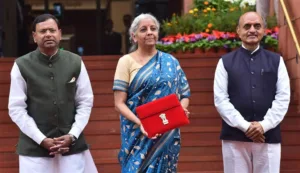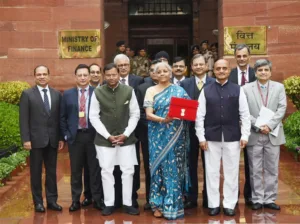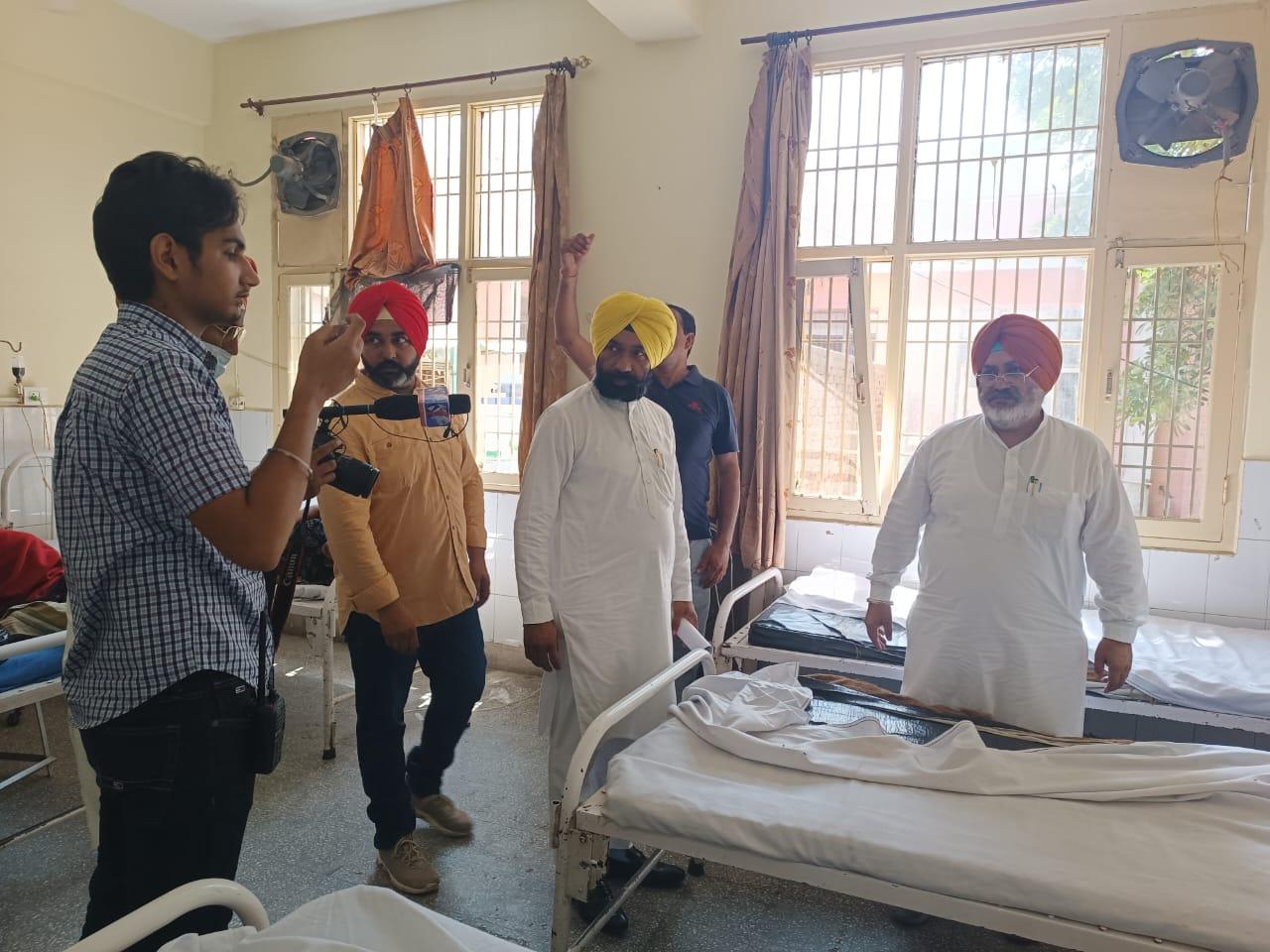The key highlights of 2024 interim budget-Hanief
Mohammad Hanief/ February 3,2024
The 2024 interim budget presentation brought forth a slew of transformative initiatives aimed at bolstering various sectors of the economy and addressing pressing societal challenges. From innovative schemes fostering renewable energy adoption to strategic investments in healthcare and agriculture, this budget outlines a vision for inclusive growth and sustainable development.
Union finance minister Nirmala Sitharaman on Thursday presented the interim budget ahead of the end of the 2024 Lok Sabha elections. This marks her sixth Budget as the finance minister and the last in the second term of the Modi government.
Sitharaman adhered to tradition on Thursday by visiting President Droupadi Murmu before unveiling the pre-election Budget for 2024-25. She met with the President at Rashtrapati Bhawan before proceeding to Parliament.
The budget focused on fiscal consolidation, infra, agri, green growth, and railways. However, no changes were made in the tax rates, which was a disappointment to salaried individuals. The Fiscal Deficit target for FY25 was set at 5.1 percent of the GDP, better than expected, while the FY24 target was also revised down to 5.8 percent. Meanwhile, the capex target of FY25 was increased by 11.1 percent to Rs 11.1 lakh crore.
“The Indian economy has witnessed a positive transformation in the last 10 years. People are looking towards the future with hope. In 2014, the country was facing enormous challenges. With Sabka Saath, Sabka Vikaas, the Narendra Modi-led government overcame those challenges,” has said Finance Minister Sitharaman in her budget speech.

The next 5 years will be years of unprecedented development and to realise the goal of becoming a developed country by 2047, Sitharaman stated and added that the “trinity of democracy, demography and diversity can fulfill aspirations of every Indian”.
The finance minister has continued to focus on strengthening of domestic macro factors including sustained investments in Infra, Agriculture, Domestic Tourism, and also sticking to fiscal responsibility with a lower fiscal deficit which could be music to the ears of foreign investors and impending $25 billion bond inclusion in June as lower budget deficits and pared borrowings will help bring down yields.
Key features of the budget are a focus on infrastructure, tourism, logistics, and innovation in research. All these measures will bring continuous sustainable growth to the economy. This shows the continued commitment of the existing government to move towards bringing fiscal prudence and reaching the targeted fiscal deficit of 4.5 percent of GDP by FY26.
While no changes were seen in the tax regime in this budget, the finance minister announced that over the last 10 years, tax collections have more than doubled and also pointed out that the average processing time of tax returns was reduced to 10 days this year.
The Finance Minister reports a significant milestone, citing a doubling of tax collections over the past decade. Notably, the current budget maintains the status quo in both direct and indirect taxation, including import duties. Companies may find this predictability beneficial in navigating their financial planning, fostering a more secure and sustainable business environment.

Building on the massive tripling of the capital expenditure outlay in the past 4 years resulting in a huge multiplier impact on economic growth and employment creation, the outlay for the next year is being increased by 11.1 percent to 11.11 lakh crore, announced the FM. This is 3.4 percent of the GDP.
FM Sitharaman announced that 40,000 normal rail bogies will be converted to Vande Bharat to enhance the safety, convenience, and comfort of passengers. Key rail infrastructure projects including Metro Rail and Namo Bharat will be expanded to more cities. Also three major railway corridors were also announced – the port connectivity corridor, the energy, mineral, and cement corridor, and the high traffic density corridor.
The resultant decongestion of the high-traffic corridors will also help in improving the operations of passenger trains, resulting in safety and higher travel speed for passengers. Together with dedicated freight corridors, these three economic corridor programs will accelerate our GDP growth and reduce logistic costs.
After the success of Vande Bharat trains, the FM announced around 40,000 more rail bogies will be converted to Vande Bharat coaches. This will further create job opportunities while reducing travel time as well as increasing tourism across the country.
The development of commodity-specific economic rail corridors can de-congest existing lines, mostly in the eastern part of the country. This is supportive of faster freight movement and turnaround times and should help reduce the logistics cost for India from 12 percent of GDP, improving competitiveness, especially manufacturing, against peers.
Viability gap funding will be provided for harnessing offshore wind energy potential for the initial capacity of one giga-watt. Coal gasification and liquefaction capacity of 100 MT will be set up by 2030. This will also help in reducing imports of natural gas, methanol, and ammonia.
Phased mandatory blending of compressed biogas (CBG) in compressed natural gas (CNG) for transport and piped natural gas (PNG) for domestic purposes will be mandated. Financial assistance will be provided for procurement of biomass aggregation machinery to support collection.

The government will expand and strengthen the EV ecosystem by supporting manufacturing and charging infrastructure, the finance minister has said and added that greater adoption of e-buses for public transport networks will be encouraged through payment security mechanisms.
Finance Minister announced that states will be encouraged to take up comprehensive development of iconic tourist centers’ branding and marketing at a global scale.
A rating system based on the quality of facilities and services will be established. Long-term interest-free loans will be provided to states for financing these developments. Projects for port connectivity, tourism infrastructure, and amenities will be taken up on our islands, including Lakshadweep, this will help in generating employment as well.
The FDI inflow during 2014-23 was $596 billion marking a golden era. That is twice the inflow during 2005-14. For encouraging sustained foreign investment, the government is negotiating bilateral investment treaties with foreign partners, in the spirit of ‘first develop India’, said finance minister in her speech.
New-age technologies and data are changing the lives of people and businesses. They are also enabling new economic opportunities and facilitating the provision of high-quality services at affordable prices for all, including those at the ‘bottom of the pyramid’.
She announced a corpus of rupees one lakh crore will be established with a fifty-year interest-free loan. The corpus will provide long-term financing or refinancing with long tenors and low or nil interest rates. This will encourage the private sector to scale up research and innovation significantly in sunrise domains.
The Skill India Mission’s initiative to train 1.4 crore young individuals, along with the upskilling and re-skilling of 54 lakh youth, coupled with the establishment of 3,000 new Industrial Training Institutes (ITIs), is a vital step towards bolstering the PLI and Make in India programs. This comprehensive approach is essential in enhancing the manufacturing sector’s contribution to the GDP from 17 percent to 25 percent by 2047, thereby creating numerous job opportunities.
To ensure faster growth of the sector, the government will further promote private and public investment in post-harvest activities including aggregation, modern storage, efficient supply chains, primary and secondary processing, and marketing and branding.

NOTE: The views expressed are personal. The author can be mailed at [email protected] or X (Twitter): @haniefmha










